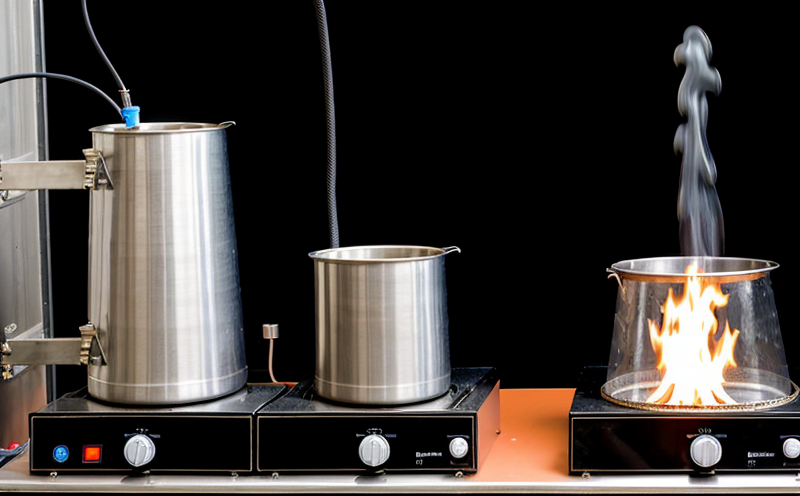Total Heat Release Measurement of Materials
The Total Heat Release (THR) measurement is a critical aspect in fire safety testing. This service evaluates how much heat energy is released by materials when exposed to an ignition source, quantifying the total amount of heat that can be expected from burning items under specific conditions.
This test provides valuable insights into the flammability and thermal stability of materials used in various industries such as textiles, automotive components, furniture, and construction. Understanding the THR is essential for ensuring compliance with international standards like ISO 56604:2017 and ASTM E907-18, which outline the procedures for measuring heat release rates.
The test involves placing a specimen in a calorimeter where it is subjected to an ignition source. The calorimeter captures the amount of heat generated by the burning material over time. This data helps manufacturers make informed decisions about material selection and design improvements aimed at enhancing fire safety.
Preparation of specimens for THR testing typically includes ensuring uniformity across samples, adhering to standardized dimensions as specified in relevant standards. The choice of specimen size can vary depending on the specific application; however, a common approach is to use specimens that are 10 cm by 15 cm or similar dimensions.
Instrumentation used for this service includes sophisticated calorimeters capable of accurately measuring heat release over time. These devices come equipped with sensors and software that allow for precise data collection and analysis. Reporting from these tests involves presenting the results in a standardized format, often including peak heat release rate (PHRR), total heat release (THR), and other relevant parameters.
Compliance with international standards ensures consistency and reliability of test results across different laboratories worldwide. This is particularly important for manufacturers who need to meet regulatory requirements or participate in global markets where fire safety is a concern.
| Key Parameters | Description |
|---|---|
| PHRR (Peak Heat Release Rate) | The maximum heat release rate measured during the combustion process. |
| Total Heat Release (THR) | The total amount of heat released by a material over its entire burning period. |
| Time to Peak PHRR | The time taken for the heat release rate to reach its peak value. |
These parameters are crucial in assessing the fire hazard potential of materials. By understanding these values, manufacturers can identify areas where improvements could be made to enhance product safety and comply with regulatory standards.
Eurolab Advantages
- State-of-the-art calorimeters ensuring accurate measurements.
- Comprehensive expertise in fire safety testing across various industries.
- Strict adherence to international standards, guaranteeing reliability and accuracy of results.
- Experienced technical staff providing detailed insights into test methodologies and outcomes.
At Eurolab, we pride ourselves on offering a full range of services tailored to meet the specific needs of our clients. Our team of experts ensures that every project is handled with precision and care, ensuring compliance with all relevant regulations. With years of experience in this field, Eurolab remains at the forefront of fire safety testing innovation.
Environmental and Sustainability Contributions
The Total Heat Release measurement plays a significant role not only in enhancing fire safety but also in promoting environmental sustainability. By identifying materials with lower heat release rates, manufacturers can reduce the risk of fires and minimize the environmental impact associated with fire incidents.
Burned materials contribute significantly to air pollution through the release of toxic gases and particulate matter. Lowering the heat release rate of materials helps mitigate these impacts, contributing positively to public health and reducing carbon footprints. This aligns with broader sustainability goals within industries like construction and automotive.
Moreover, this service aids in developing safer products that meet stringent environmental regulations. For instance, the European Union’s Restriction on Hazardous Substances (RoHS) directive aims at minimizing hazardous substances in electronic and electrical equipment. Understanding the total heat release of materials can help manufacturers choose alternatives that are both safe and environmentally friendly.
At Eurolab, we recognize our responsibility to contribute to a more sustainable future through innovative testing solutions. Our commitment to excellence extends beyond compliance; it includes proactive measures towards reducing environmental impact while ensuring product safety and quality.
Use Cases and Application Examples
- Furniture manufacturers assessing the flammability of new upholstery materials.
- Automotive companies evaluating interior components for fire resistance.
- BUILDING MATERIALS: Testing wall coverings, insulation panels, and ceiling tiles.
- Textile producers ensuring compliance with flammability regulations.
| Use Case | Description |
|---|---|
| Furniture Industry | Evaluating the total heat release of cushion foams, upholstery fabrics, and decorative materials to ensure they meet fire safety standards. |
| Automotive Sector | Testing seat covers, door panels, and other interior components to assess their flame resistance properties. |
| Building Materials | Assessing the thermal stability of wall coverings, insulation boards, and ceiling tiles used in construction projects. |
| Textile Industry | Ensuring that fabrics and other textile products comply with flammability regulations set by various jurisdictions. |
These examples illustrate the broad applicability of total heat release measurement across different sectors. Whether it's enhancing product safety or supporting compliance efforts, this service offers valuable insights into material performance under fire conditions.





